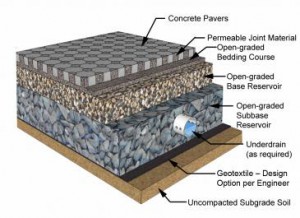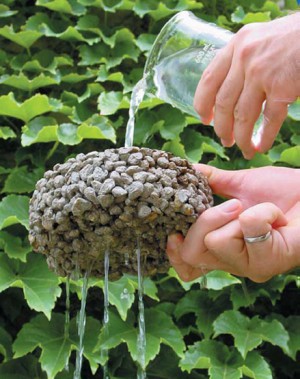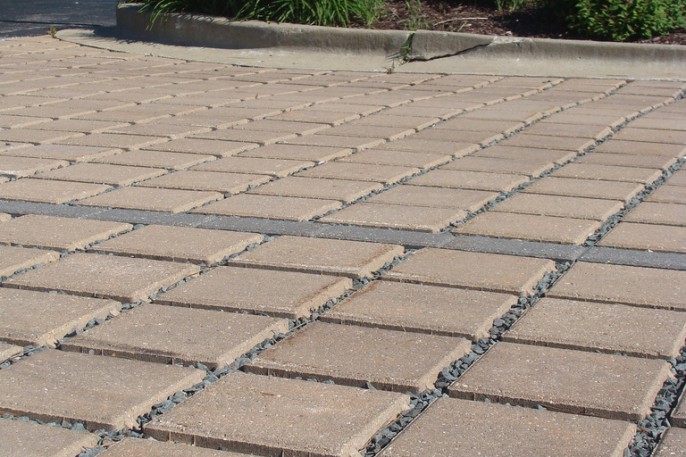Pervious Pavers
Pervious pavers, also known as porous concrete, porous pavement, gap-graded concrete, or enhanced porosity concrete, are comprised of concrete bricks, separated by joints, or gaps, filled with small stones or sand, which are laid over a bed of aggregate stones. Water is able to infiltrate through the joints in the pavers, and is stored in void space underneath the paver surface, where it is then filtered back into the soil.
Pervious pavers serve the same purpose as pavement- allowing people to walk, drive and park on them, but unlike impervious pavement- they can provide the environmental benefit of stormwater treatment and capture. By replacing existing concrete sidewalks and driveways, and also incorporating pervious pavers into new construction, communities can greatly improve their water quality.

Pervious pavers are composed of several layers. Image courtesy: Interlocking Concrete Pavement Institute
Water that flows off of impervious surfaces, such as sidewalks, roads and driveways picks up pollutants such as trash, leaked vehicle fluids, lawn fertilizer and pet waste. The water heats up as it flows over concrete warmed by the sun and vehicle traffic, and gains speed as water volume increases. This polluted, hot, fast moving water is the opposite of what should be entering rivers. It clouds the river, blocks sunlight, kills beneficial organisms and spurs the growth of algae.
By keeping polluted stormwater out of the sewer drains that lead to the Chesapeake Bay, and instead capturing rain water where it falls on pervious pavers, streams, rivers, and ultimately the Chesapeake Bay can remain clean, clear and healthy.
Benefits of Pervious Pavers
When installed properly, pervious pavers:
- Meet U.S. EPA stormwater performance criteria for a structural BMP
- Reduce amount of nutrients entering the waterways
- Reduce combined sewer system overflows by lessening the amount of water that enters combined sewers
- Provide 100% pervious surface in up to 3 inch rain event
- Reduce or eliminate need for retention ponds or storm sewers when implemented with new construction
- Trap vehicular and residential pollutants
- Reduce heat island effect due to evaporation
- Are low maintenance
- Localized replacement of paving units with no unsightly patches.
- Requires less salt to defrost ice and snow in the winter
- Yearly upkeep is minimal
- Replenishing aggregate if necessary
- Removing debris from aggregate
- Can be safer than impervious concrete
- Pavers allow melting snow and ice to infiltrate, lessening the probability of black ice.
- Naturally brighter and reflects more light, increasing nighttime visibility.
- Provides more traction for pedestrians and vehicles, especially in inclement weather.
Installing Pervious Pavers on Your Property

The pore space in pervious pavers allows water to flow thorugh into the underlying void space. Image courtesy: National Ready Mix Concrete Association
While the long-term benefits are significantly greater, the initial cost of installation for pervious pavers is exceeds that of impervious concrete or pavement. All pervious paver systems must be installed by an Interlocking Concrete Pavement Institute (ICPI) certified contractor. Not all companies are certified.
Though pavers are ideal for generally low traffic areas, they are not recommended for high-speed/high-volume traffic roadways.During winter weather, sand can not be used for snow and ice removal as it may clog the underlying pore space. Thus, a shovel, plow or minimal salt should be used instead for winter deicing.
If you are interested in installing pervious pavers on your property:
- Research contractors in your area that are certified to install pervious pavers. Interlocking Concrete Pavement Institute registered contractors can be found using online search engines or by going to www.icpi.org. Here you can search for registered contractors by state or zip code. (It is recommended that you obtain several contractor bids for your project.)
- Work with your contractor to determine which color, design and material you like, and what is appropriate for your project and its intended use.
- Have your pervious pavers installed and enjoy them knowing that you are helping to purify and recharge your groundwater by capturing stormwater runoff!

